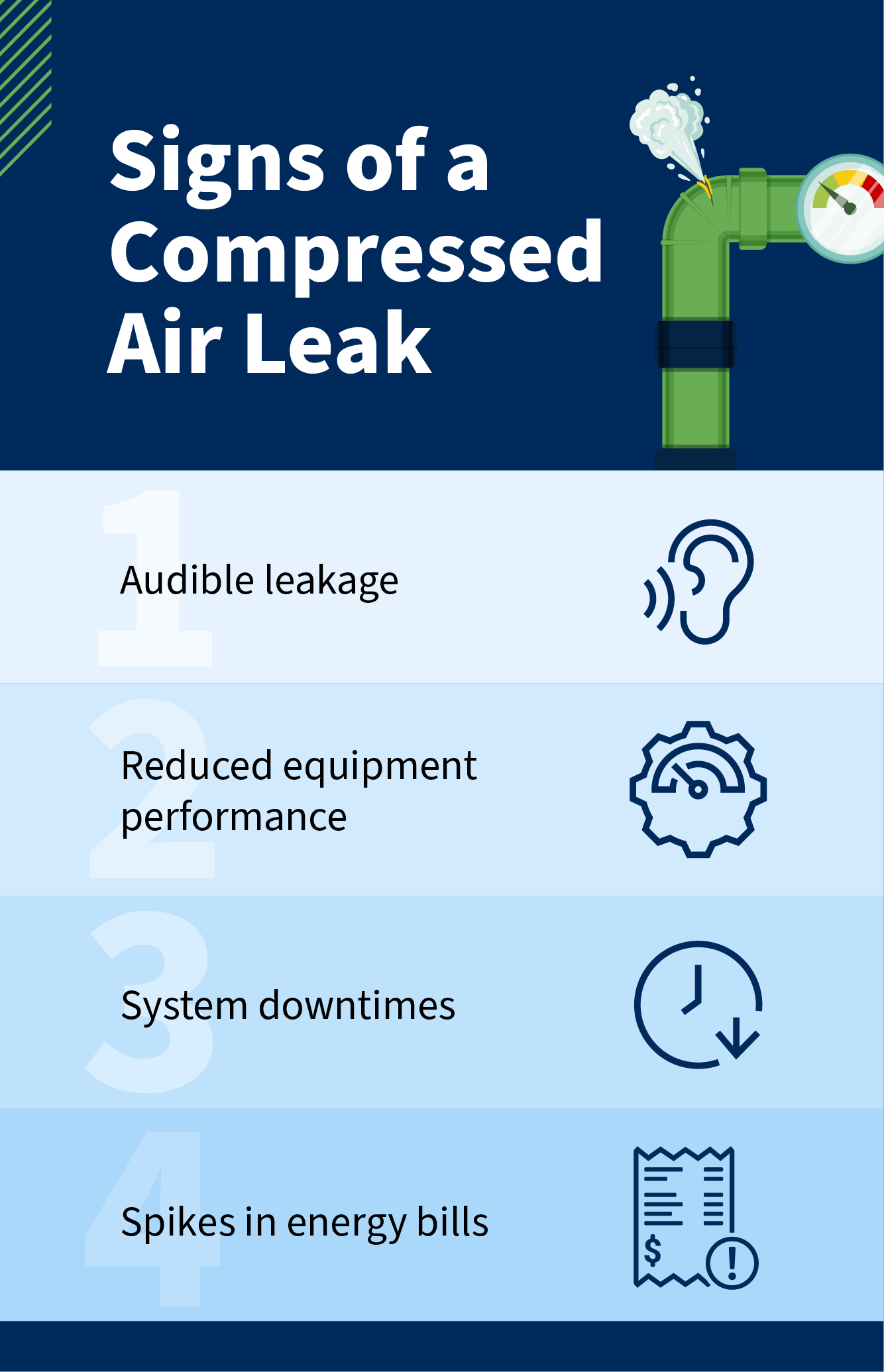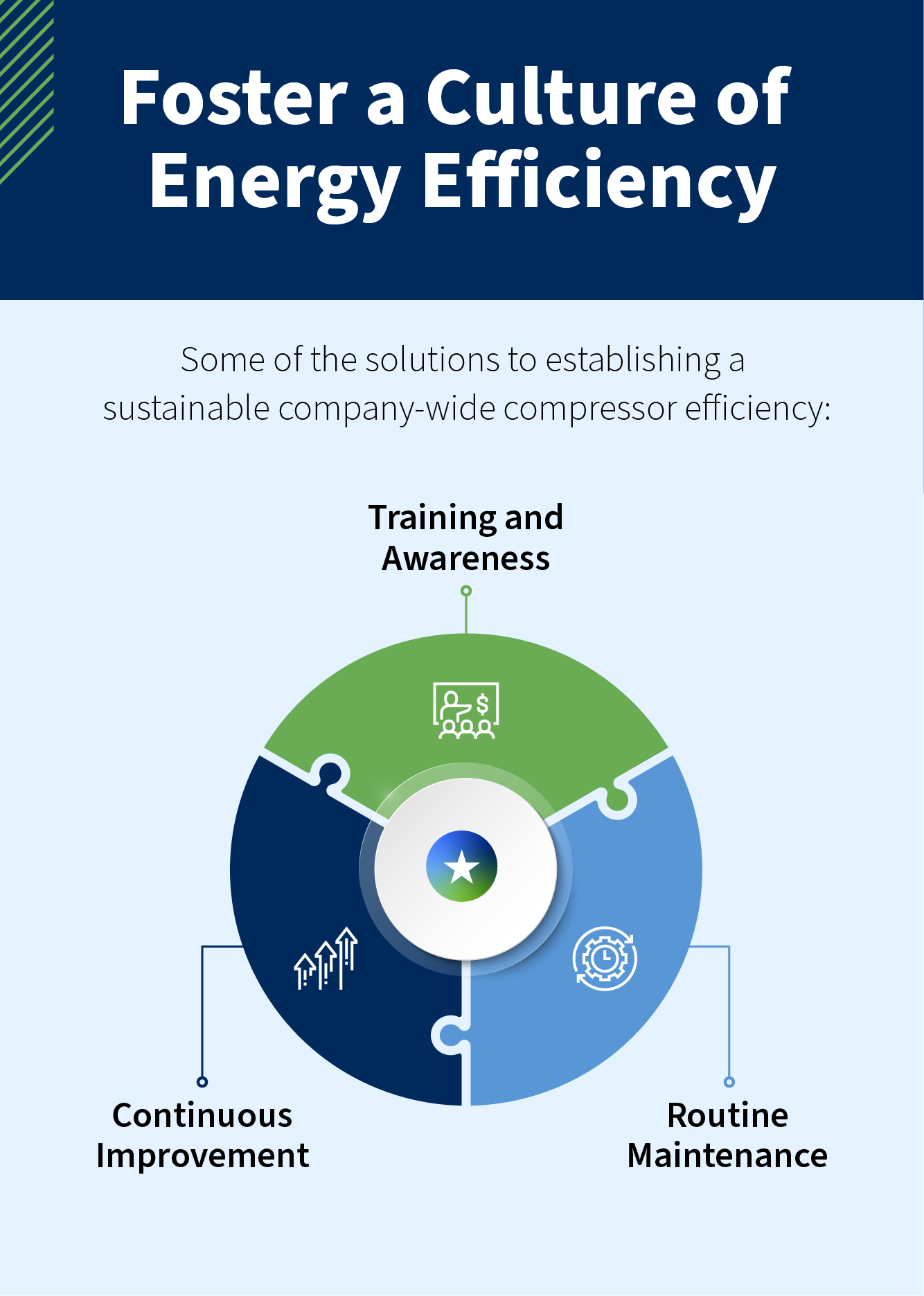How to Improve the Energy Efficiency of a Compressed Air System
Compressed air is critical in many industrial and non-industrial applications, from powering pneumatic tools and conveyor systems to cleaning equipment and airfilling amusement park objects. While pressurized air is an indispensable source of power, compressed air systems are some of the most energy-intensive machines.
Improving the efficiency of a compressed air system can positively impact a business’s bottom line. This guide from Quincy Compressor explores practical tips for increasing the energy efficiency of compressed air systems and lowering operating costs.
1. Understand the Existing System
The first step to curbing power wastage and improving the efficiency of your compressed air system is to conduct a comprehensive audit of your existing system. A professional analysis of the compressor will help you identify areas of improvement, allowing you to create a strategy for cost savings. Typically, a professional system audit involves:
- Performance analysis: This is an evaluation of how the machine operates, including the standard operating hours, energy consumption, pressure levels and air output. Conducting performance analysis and recording data over a specific period allows a technician to see how the system behaves under different conditions.
- Existing applications: A walk-through of the entire facility provides data on the various processes that require compressed air. Detailed data on use cases is key to identifying wastage and inappropriate uses.
- Identifying challenges: Once a professional collects the necessary data, they analyze it to gain insight into issues and identify patterns of inefficiency. These vary, from inconsistencies between air supply and demand to energy drain outside production hours.
Analyzing your existing system and identifying its challenges is necessary if you want to prioritize solutions based on impact.
2. Optimize Pressure Drop
It’s challenging to avoid a pressure drop in a compressed air system, as doing so requires the compressor to operate at a higher pressure. However, the higher the compressor discharge pressure, the more power it consumes. If you increase the operating pressure by 2 pounds per square inch gauge, the machine’s power consumption increases by 1%.
Therefore, optimizing the system for efficiency lies in minimizing the pressure drop to no more than 10% between the compressor discharge and the point of use. Any more than this means your system uses excess energy.
There are different factors responsible for the amount of pressure drop in compressed air systems, such as piping diameter, surface texture, fittings and valves, air speed, and air treatment equipment. These factors can significantly reduce air consumption and cause high pressure drops in the system.
An air system assessment will provide valuable data to help you maintain minimum pressure drop and improve efficiency.
3. Eliminate Leak Sources
Leaks that go unnoticed in compressed air systems can lead to significant losses due to power wastage and reduced productivity. For example, a system audit of Mikron Industries found leaks in about two-thirds of the facility, which were estimated to cost the company $157,000 annually.
Compressed air distribution systems need an up-to-date piping network that eliminates leak challenges common with outdated piping systems. Current industry advancements have led to piping systems made from reliable materials and fittings that offer low pressure drop and accommodate modifications to address leak sources.
Identifying a Compressed Air Leak
Compressed air leaks can be silent energy wasters in commercial and industrial facilities. How do you know that your system has air leaks? Here are key signs to watch out for:

- Audible leakage: Due to the high pressure of the escaping air, whistling or hissing sounds are common with leaky compressed air systems. However, some leaks are inaudible and, therefore, harder to detect.
- Reduced equipment performance: Leaky compressors are inefficient and likely to perform poorly, resulting in low output.
- System downtimes: Frequent compressor downtimes can be a result of unidentified leaks. Since the machine works harder to compensate for the constant pressure loss, it suffers wear and breaks down more frequently.
- Spikes in energy bills: An unnoticed air leak significantly increases energy costs. That’s because the system uses more power to compensate for the lost air and meet the required output.
Remember, compressed air leaks can easily go unnoticed. You may fail to identify any of the above signs without professional auditing, especially if you have a large operation. Some leaks are inaudible. You may also attribute spikes in energy use or low equipment performance to other existing issues. It’s best to schedule a system-wide energy audit for a more accurate picture.
4. Choose the Appropriate Compressor
An effective way to ensure the energy efficiency of a compressor from the get-go is to install the appropriate compressed air system for your facility. Here are a few considerations for selecting the right compressor to maintain efficiency:
- Variable speed drive (VSD) technology: VSD technology allows industrial machines equipped with it to adjust motor speed according to the demands of a specific application. Choosing compressors with VSD is ideal for applications that require dynamic air demand — the machine consumes only as much energy as needed.
- Centrifugal compressors: These heavy-duty compressors use a dynamic compression process that makes them efficient for large-scale air demands. Modern centrifugal compressors come with advanced impellers designed to meet airflow and pressure requirements.
- Sizing requirements: Proper sizing is critical when selecting compressed air systems. Oversized options waste energy, while undersized options struggle to meet demand and withstand pressure fluctuations. You want to pick a compressor size that matches your needs to improve efficiency.
- Oil-free and oil-flooded compressors: The choice between oil-free air compressors and their oil-flooded alternatives depends on your needs. That said, oil-free alternatives generally have reduced leaks and energy consumption.
5. Optimize Compressor Controls
Compressor control systems play a huge role in energy efficiency, especially in multi-compressor systems that require a more complex control solution. Compressor controls determine when systems run, so with multiple compressors, it’s necessary to determine which unit operates and when to use automation.
How does optimizing compressor controls help with energy efficiency? Here’s an overview of sequence control and optimized central control and how each performs.
Sequence Control
A start sequence control system can be programmed to react to system pressure drops, where an extra compressor switches off the load running if the pressure drops. Since the sequence remains the same, even with the use of VSD-powered units, pressure volumes will always be higher than required, leading to high energy bills.
Optimized Central Controls
With optimized central controllers, the intuitive system is capable of connecting all compressors, reducing the pressure band and optimizing performance for energy efficiency. When pressure drops, a sequence controller simply selects the next unit regardless of capacity. An optimized controller chooses the ideal compressor combination to efficiently meet the required air demand. In case of a significant pressure drop, it selects the unit with the largest capacity to compensate.
6. Implement Heat Recovery
Implementing heat recovery doesn’t necessarily reduce the energy consumption of your compressor, but it does improve the overall efficiency of your system. Up to 90% of the electrical energy a compressed air system consumes is never used and is converted into heat.
Recovering the generated heat from air compressors eliminates excess wastage, as you can repurpose the heat to cut costs in other areas of the facility. For example, you can use recovered heat to cover other energy-intensive activities such as:
- Space heating: Heating one or more areas of a facility, especially in the winter, is already energy-intensive. Space heating is an ideal use for recovered waste heat.
- Water heating: Heated water is needed in many industrial applications. Instead of draining electricity to heat water, you can reuse the heat waste from your compressor for this purpose.
- Heat-specific applications: Recovered compressed air heat is an effective solution for powering heat-specific operations already common in many industries. These processes include cleaning, refining, drying, melting and more.
7. Optimize the End-Use
The most efficient compressed air systems still fail to be energy-efficient if there’s an issue at the end use that results in lost air. Here are some of the steps to take to optimize end-use solutions:
- Use efficient equipment: Poor-quality nozzles and piping could lead to the use of more compressed air than necessary. Examine pneumatic cylinders to ensure they are sized correctly for their specific applications.
- Alternative solutions: Owning a compressed air system doesn’t mean it’s the most efficient solution for all applications. There may be alternatives for specific use cases around your facility that can increase your energy savings. Examples include vacuum pumps and low-pressure blowers.
- On and off automation: Simply turning off compressed air systems when not in use offers ample energy savings. Considering human error is a common cause of damage and loses, a strict on-off policy may not be as effective as an automated shut-off solution.
8. Implement Proper Design
Compressors with a well-designed distribution system offer better performance and efficiency. A loop system design for air distribution, for example, is better than dead-end lines. It provides the air with multiple paths to reach the end-use point, improving airflow and reducing pressure drops.
An effective piping system should also have fewer bends and fittings. These restrictions promote pressure drops, and the same goes for incorrect sizing.
In addition, the system should use automatic drains on air receivers and filters to prevent condensate buildup responsible for accelerated corrosion and increased pressure drops.
9. Foster a Culture of Energy Efficiency
While focusing on technical aspects is necessary to improve the energy efficiency of your compressor, it’s important to consider a comprehensive approach to creating a sustainable energy efficiency program. Many of these technologies and smart strategies rely on a vital component — your team.
For a system that can easily account for 30% or more of all industrial power consumption, it’s wise to establish a culture of energy efficiency to nurture a collective mindset that drives energy goals. Here are some of the solutions to establishing a sustainable company-wide compressor efficiency:
Training and Awareness
Knowledge is key to helping employees understand the implications of inefficient compressed systems. Create device training programs for use across all employee groups, from operators and maintenance technicians to the management staff. Practical skills in operation and troubleshooting reduce human error, improve maintenance and boost awareness.
Routine Maintenance
Compressors rely on routine maintenance for optimal performance. Consider implementing a proactive maintenance plan that goes beyond reactive repairs. Develop an effective preventive maintenance strategy your team or technicians can follow to ensure efficiency.
Continuous Improvement
Long-term compressor efficiency requires continuous improvement and adaptation to changing needs. Schedule periodic system audits to collect performance data and identify areas of improvement, from leak detection to full compressor replacement. As new advancements in compressed air technology emerge, you want to adapt and take advantage of more energy-efficient solutions.
Maintaining Energy Efficiency of Compressed Air Systems
Addressing the energy efficiency challenges of your compressed air system offers a powerful solution to cutting operating costs, improving overall facility operations and reducing your facility’s energy footprint. To maintain long-term energy efficiency, a holistic approach combining technical aspects and a commitment to ongoing optimization is necessary.
Compressed air systems are a must-have machine in many industries. However, their relevance doesn’t mean you must bear crippling energy bills. Try the recommended solutions such as investing in air audits, resolving leaks and optimizing compressor controls. If energy waste is still a concern, consider advanced strategies like automation, heat recovery and upgrading to the latest systems.


